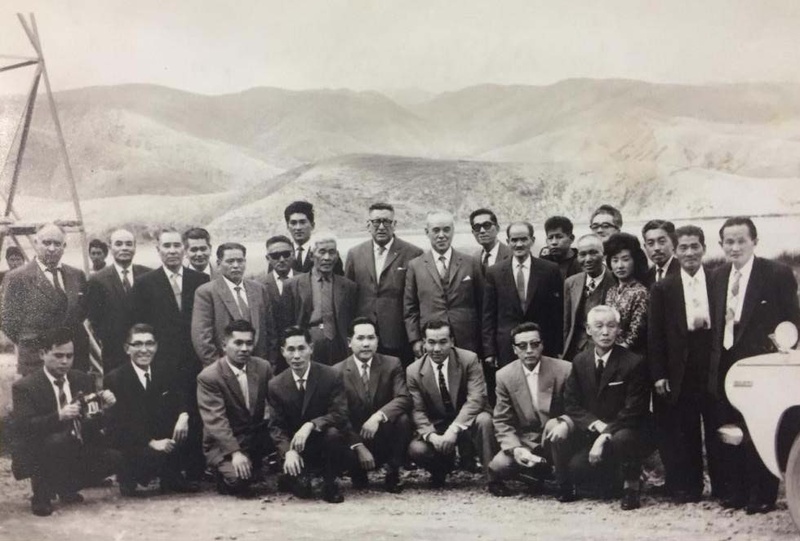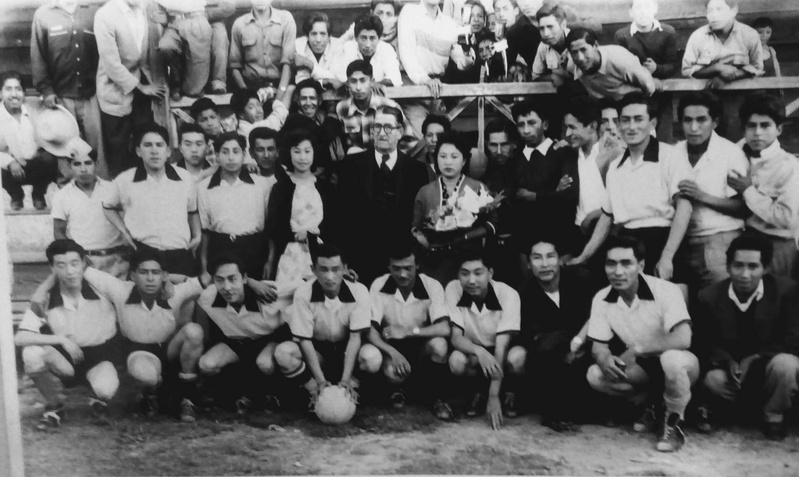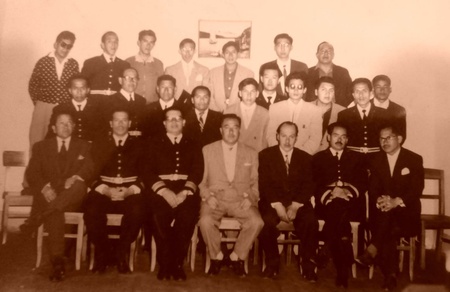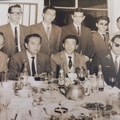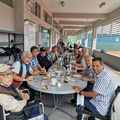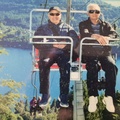There are those who say that remembering is living again. And in these last years of life that I live, my life is through happy memories. Life has been so long in a matter of years and so short in the nostalgia that I feel again today. Childhood and youth are two stages in life that come together at the end of the road. Find the desire to live just by remembering them.
It was on a pouring rainy night in November 1948 that I arrived at my new destination. From Lima, who lived with the family of Mr. Hirano Matsumura, since 1944, to my new home with the Araki Miyada family, in the city of Jauja. I remember a late model Chevrolet car owned by Mr. Araki and Mr. Nishimura and Iwamoto, and Mrs. Máximina Miyada, in the company of a cage with canaries. All of them and me on a trip from coast to mountains. Climb up to 4,200 meters above sea level and then go down to 3,600 meters, which is where Jauja is located, in the heart of the Mantaro Valley.
At the age of eight it is not easy to leave one family for another, in Lima, in the Barrios Altos where we lived, the memories of friends and neighbors are frequent on nights of crying and sorrow. Only when the days turned into months, and the refuge of new friendships emerged with each new dawn, the tranquility of a new home was reflected in how my life as a moth became more noticeable and frequent as the years passed.
I liked school but not studying. In it I could play with my friends during recess, and also on days when one was absent from school, and go with the gang to play soccer, while, in class, our places were only empty folders and a teacher who told us. He was waiting with a whip in his hands.
Jauja was a quiet town and I always saw it that way. To this day it seems to me that nothing has changed. Only the remodeling of its Main Park and today I see it not as pleasant as in my childhood days. Otherwise, the stores are almost the same, only their owners have changed. seventy years later. Today no member of the Japanese colony no longer lives in the city of Jauja. The last of my friends, José Kato, died two years ago.
The city of Jauja until 1960 was known for tuberculosis patients. Its precious climate helped prevent the terrible disease from advancing. Only with the arrival of penicillin was it that little by little the sick were cured in their cities and no longer had to take refuge here. Statistics show us, with the help of the provincial municipality, that the first Japanese patients who arrived in the city and died date back to 1915. That is, 16 years after the arrival of the First Japanese Immigrant Ship that arrived in Peru (1899 ). Jauja was the refuge for anyone who felt bad due to tuberculosis. Many arrived with their families and formed small businesses to make life more bearable.
It was a small Japanese colony where we all knew each other. We sunbathed in the Main Park and met all our friends and acquaintances. Twenty-five families and ten young people were more or less those who lived in the city, with businesses in different areas. Encomenderias, restaurants, bazaars, photography studios, hairdressers. The largest businesses were Mr. Máximo Umemoto's grocery store and the Higuchi family's Sparkling Water bottling company.
Around 1953, the Los Andes Club had been formed, with members of the Japanese colony and its headquarters in Jirón Grau. In their premises they played ping pong and different board games. A baseball team delighted in practicing every Saturday and agreed games were played with the Ninth of the Nisei Huancayo National Association.
In 1958, the Nisei Jauja Club was formed based on football. By the second year we were already in the First Division, alternating with the best teams in the city: Deportivo Municipal, Once Estrellas, Hatun Xauxa, Sport Samaritana, Deportivo Olavegoya, United Students, Andean Hurricane, etc.
I was lucky enough to be the first president of this new institution, my period culminated with the formation of the Jauja Fire Company No. 1. My friend Víctor Aritomi from Huancayo, who at that time presided over the Association, helped me throughout this campaign. Nisei Huancayo National. He was also a member of the Huancayo Fire Company, where several Niseis Huancaínos were active firefighters: Crisanto Shiraishi, Arnaldo Uchiyama, Pedro Aritomi, Alberto Okugawa, Carlos Yamaguchi and Víctor Aritomi, between 1958 and 1960.
The Japanese colony in the city of Jauja was respected and loved by the entire population. Three of its members became mayor of the city. They were Juan Higuchi, Pedro Onaka and José Yseki. And, according to what my friend José Kato told me, the Japanese colony donated the lighting poles on Ricardo Palma Avenue, a piece of land near the cemetery, and carried out many works in favor of the city.
When penicillin arrived in the country, it greatly reduced the number of patients suffering from tuberculosis and, little by little, the Japanese colony left the city. Today, as my friend José Kato told me, only the dead remain who rest in the General Cemetery. In these 60 years that I have left the city of Jauja, from time to time I go to the Campo Santo to visit my old friends. Hundreds of Japanese names and surnames adorn the mausoleums. Being so far from their relatives in Japan, the Iseis who arrived as immigrants on cargo ships, today, thanks to the noble people of Jauja, sleep eternal sleep in the simplest tranquility that a body can rest.
Author's note:
I still remember the names and surnames of many Nikkei just by walking the streets of Jauja:
The brothers Genaro, Fortunato, Juan, Josefina and Benigna Higuchi; Máximo and José Umemoto; Luis, Roberto, Daniel, Julio and Yolanda Makino; Roberto Aymoto, Rricardo Watanabe, Mrs. Ayko, José and Ricardo Otsuka, Mr. Nakachi, Nakamura family, Hiroshi, Roberto, José and Rosa Kato; Olga and Kanashiro brothers; Jose Yonemoto; Benito Araki and Maximina Miyada; Mr. Miki and family; Javier Ishibashi and Mrs. Pedro Onaka, mother, wife and children Takaki, Chibi and Kimi; Mr. Muruchan and son. Yamashiro family, Mr. Onuma, Julio and Eduardo sons. Mr. Kamita and daughter; Mr. Saito and family.
Miyahira family, Rosa, Tsuneo and siblings; Tamakawa family; José Fukushima, wife Mercedes and daughters; Yolanda, Iris, Toya and sister; Antonio Makino, wife and son; Nobuo Taniguchi and Mrs.; Enrique Higa, wife Carmen Kiyan and their children Ana, Margarita and Julián; Alberto Ishii, wife and children. Joaquín Kanashiro, wife and children; Yamamoto family; Alfonso Chinen, mother and sister. Antonio Yseki, wife and children; Fernando Nakasone, wife and children; Jorge Tabuchi, wife Anita Matsumoto and children; Mr. Ychikawa and family; Takeuchi, Sakasaki, Furosan, Matsuda and daughter; Luis Kawano, Felipe and Ernesto Miyamoto; Jorge and Constantino Higa; José Arakaki, Pedro Goya, Yuki Nakasone, Miguel Watanabe, Marcos Nakagawa, Jorge Honda and mom.
Today in the city of Jauja, the absence of the Japanese Colony is felt throughout the neighborhood. Only some descendants have businesses and memories of the colony. And there, in the city's beautiful cemetery, more than 300 Nikkei rest their eternal sleep and enjoy the encouragement and affection of a mountain town that had them as their children. Suffering in life has its reward. In Jaujina land, a grateful people who take care of them like their own children. Only in the air do I smell the smell of broom, eucalyptus, cypress, and moist, virgin earth. And that affection of a town that knows how to love its visitors. Thanks, Jauja.
© 2020 Luis Iguchi


